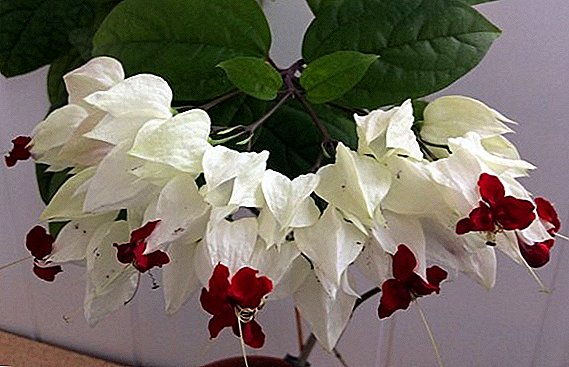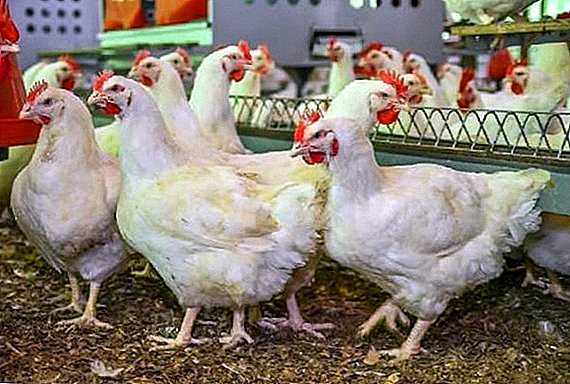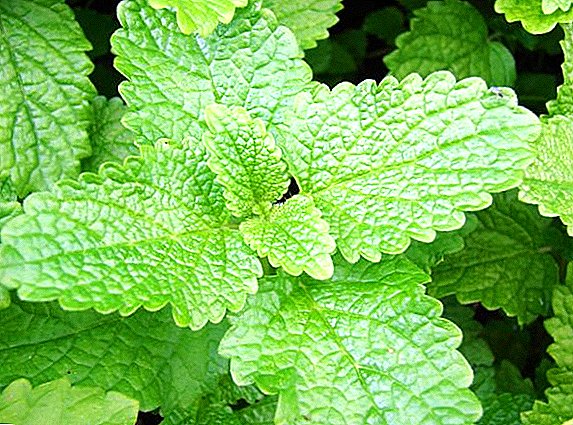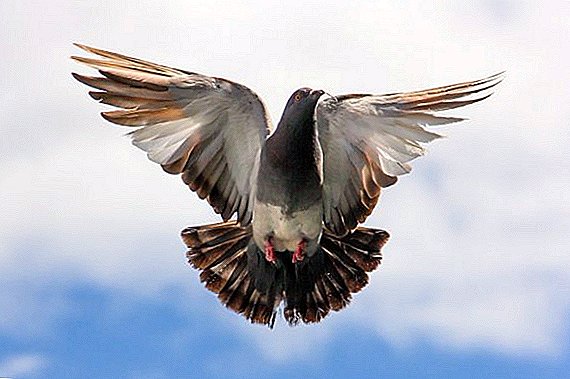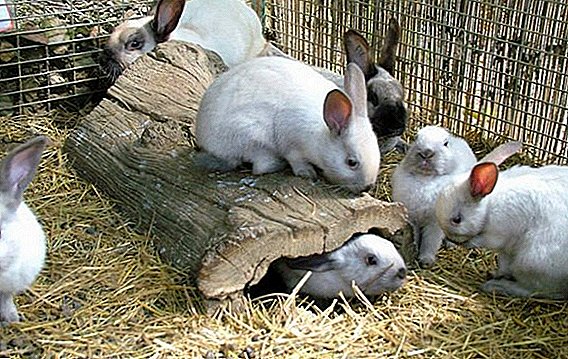 Infectious stomatitis in rabbits occurs, unfortunately, quite often due to the rapid spread of this disease.
Infectious stomatitis in rabbits occurs, unfortunately, quite often due to the rapid spread of this disease.
Individuals between the ages of 20 days and 3 months are most susceptible to it, and if the epidemic is not stopped in time, then it can destroy all livestock.
How is stomatitis manifested, how it is treated and with the help of what preventive measures of the disease can be avoided - let's look at it in more detail.
What is infectious stomatitis in rabbits
This is the name of an infectious disease affecting the oral mucosa, the tongue in animals. Accompanied by strong salivation, because of which the faces of the rabbits are moistened. For this reason, the virus is popularly known as moccasins.  The disease can occur in two forms:
The disease can occur in two forms:
- light (the innate immunity of the rabbit is in most cases able to cope with the illness itself);
- heavy (the average casement is about 30% of the population).
Having recovered animal acquires immunity for life.
Important! The quality of meat or animal skin does not affect the disease, but the offspring of such individuals is undesirable: the virus is transmitted genetically.
Why do rabbits have a wet face
The direct cause of stomatitis is considered a filter virus.
They can be infected in several ways:
- from animal carrier (actively develops in saliva, blood and urine);
- inherited;
- eating contaminated through birds or insect food;
- creating a safe environment for its occurrence (high humidity, temperature changes).
The virus is most dangerous in the case of a passive carrier, that is, a rabbit that has already had stomatitis, does not have external signs of the disease, but remains a threat to others.  The first to suffer from stomatitis are lactating or pregnant rabbits, as well as young animals up to 3 months.
The first to suffer from stomatitis are lactating or pregnant rabbits, as well as young animals up to 3 months.
The disease does not depend on the season, but due to the general weakening of the immunity in the autumn-spring period, the percentage of deaths increases.
Did you know? Rabbit per minute makes up to 120 chewing movements.
Symptoms and forms of the disease
Infectious stomatitis has two forms: light and heavy.
In the first case, the rabbits recover 10–12 days after the onset of the disease (a week and a half after the first symptoms appear) without treatment.
In the presence of a severe form, the sick animal dies on average within 4-5 days.
The type of stomatitis is highly dependent on the conditions in which the rabbits are kept. If there is a violation of sanitary standards or the number of animals is exceeded in the area, then the likelihood of a severe form increases. 
Lightweight
A light variety of infectious stomatitis can be recognized by the following features:
- redness of the mouth;
- the presence of active salivation (appears 2-3 days after infection);
- pale on the tongue, mucous membranes of the mouth;
- swollen tongue.
Did you know? Rabbits can scream, and quite loud. But they do it only at the moment of severe pain or when they are very scared.
In 2-3 days, when the disease enters the active phase, the following symptoms will appear:
- white plaque will turn into dark brown, and then in the form of crusts will begin to fall off;
- on the cleared sites small ulcers will appear;
- the tongue will acquire a bright red tint with an unhealthy sheen;
- due to abundant salivation, fur glueing will begin;
- dark streaks will appear on the skin.

Heavy
The severe form of the disease quickly depletes the animal, therefore it is characterized by:
- increased salivation;
- decreased rabbit activity;
- the desire of the animal to be hammered into the darkest corner of the cage;
- completely wet muzzle, acquiring a negligent appearance due to glued hairs and wet dirt;
- diarrhea and digestive problems.
In this state, the rabbit can withstand no more than 5 days.
If, however, to begin treatment, then, in contrast to the mild form, it will take from 10 to 14 days.
Important! The surviving individuals remain scars on the skin after ulcers, and hairline around the mouth falls out. Keep this in mind when you are going to buy rabbits or mate so as not to carry the virus.
Diagnostics
Establishing a diagnosis takes place in several ways:
- examination of diseased animals;
- the study of the epidemiological situation in the compound and in the region;
- through the autopsy.
 Inexperienced breeders often confuse infectious stomatitis with diseases in which bacterial stomatitis occurs as a result of deterioration: coccidiosis, intestinal disorders, overheating. A key factor in distinguishing diseases is the consistency of symptoms.
Inexperienced breeders often confuse infectious stomatitis with diseases in which bacterial stomatitis occurs as a result of deterioration: coccidiosis, intestinal disorders, overheating. A key factor in distinguishing diseases is the consistency of symptoms.It must be remembered that in these cases, diarrhea first appears, and then salivation, whereas abundant moisture is primary in viral stomatitis.
Another disease with similar symptoms, infectious rhinitis, is characterized by the presence of a cold.
How to treat
In viral stomatitis, the same rule applies as with other diseases: the sooner you begin to treat it, the more successful it will be to get rid of it.
Did you know? The rabbit can reach a speed of 55 km / h, yielding 15 km to its close relative - the hare.
Let's see what methods can be used to overcome stomatitis. 
Drug treatment
Mokrets is a long-known disease, so many specialized drugs have been developed for its treatment today, including:
- Streptocide powder - they need to carefully powder the inflamed mucous membranes in the pet's mouth, which is not very convenient, or, to simplify the procedure, it can be diluted into a thick emulsion, based on a dosage of 0.2 g per 1 individual;
- the "Baytril" solution - with its help it is necessary to carry out rinsing of the oral cavity 2 times a day;
- liquid preparation "Biomitsin" in the dosage of 0.02 g per 1 animal - daily bury in the mouth;
- Drops "Sulfadimezin" (0.2 g) - they help get rid of stomatitis, if you bury them 2 times a day for 2-3 days.
If you are engaged in rabbit breeding, then it will be useful for you to find out which rabbits are susceptible to: pasteurellosis, listeriosis, myxomatosis, encephalosis, versicolor, VGBK, rhinitis, and also eye and paw diseases.
Folk remedies
If you do not have the above medicines on hand, then emergency assistance can be provided by popular methods. They may not be able to cope with severe forms of stomatitis on their own, but they are able to slow down the progression of the disease.  Among such means:
Among such means:
- potassium permanganate - rinse the oral cavity with a 15% solution, and even better - douche twice a day;
- Penicillin is the first antibiotic created by man, it is used by various methods: subcutaneously (thus, 20-30 thousand units of the drug are ingested into the rabbit's body) or intramuscularly (efficacy is higher - 40-50 thousand units);
- penicillin ointment - in this case, a tool in which at least 200 thousand units of antibiotic for 160-170 g of vaseline is suitable, you should treat the affected mucous area twice a day with ointment.
Important! Some experienced livestock breeders use a solution of copper sulphate against stomatitis. They are treated with fur around the muzzle, and also make oral douching 1-2 times a day.
Prevention
Preventive measures in this case are simple:
- when infected individuals are detected, they must be isolated from healthy ones;
- adhere to hygiene standards in the rabbit room;
- provide livestock quality food, nutritious and easily digestible in composition;
- if there is a threat of infection, periodically give iodized water to rabbits (5 ml iodine per 10 liters of water);
- as an alternative to iodine, potassium permanganate can be used;
- be sure to disinfect the cells after sick animals.
 However, timely vaccination will be the most effective way to prevent stomatitis.
However, timely vaccination will be the most effective way to prevent stomatitis.Infectious stomatitis is an unpleasant disease, but easily treatable. It will not cause significant harm if you regularly inspect the rabbits for suspicious symptoms and respond promptly if they are present. The danger of stomatitis conceals only in the case of severe neglect, transformation of the disease into a severe form.




